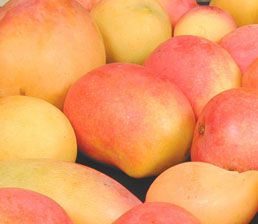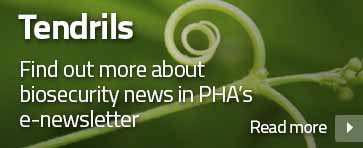 The Australian Mango Industry Association represents the biosecurity interests of mango producers and the industry. They are members of Plant Health Australia and signatories to the Emergency Plant Pest Response Deed. Their responsibilities include:
The Australian Mango Industry Association represents the biosecurity interests of mango producers and the industry. They are members of Plant Health Australia and signatories to the Emergency Plant Pest Response Deed. Their responsibilities include:
- biosecurity planning and implementation at the national and farm levels
- liaising with federal and state governments on trade issues
- funding and supporting biosecurity initiatives
- participating in national committees and response efforts in an emergency.
Industry overview
Approximately 80 per cent of fruit is consumed fresh, 10 per cent is exported and the remaining fruit is processed.
In Australia, nine varieties of mango are in commercial production. The most abundant variety, Kensington Pride, accounts for around 41 per cent of Australian production.
Other varieties include B74 (Calypso), Honey Gold, and R2E2, green eating varieties such as Keow Savoey, Falan and Nam Doc Mai, as well as late season varieties such as Brooks, Keitts, Palmers, Kents and Pearls. B74 and R2E2 are popular in export markets. There are other varieties produced in smaller volumes.
The industry supplies the Australian market, with production occurring from August to March each year. Most mangoes are grown in Queensland and the Northern Territory with smaller but significant production in regions throughout Western Australia.
Biosecurity plans, manuals and resources
Expand
 Biosecurity planning provides a mechanism for the mango industry, government and other relevant stakeholders to assess current biosecurity practices and future biosecurity needs. Planning identifies procedures that can be put in place to reduce the chance of pests reaching our borders or minimise the impact if a pest incursion occurs.
Biosecurity planning provides a mechanism for the mango industry, government and other relevant stakeholders to assess current biosecurity practices and future biosecurity needs. Planning identifies procedures that can be put in place to reduce the chance of pests reaching our borders or minimise the impact if a pest incursion occurs.
The Biosecurity Plan for the Mango Industry outlines key threats to the industry, risk mitigation plans, identification and categorisation of exotic pests and contingency plans. For a copy, please contact PHA on 02 6215 7700 or email biosecurity@phau.com.au.
 The Orchard Biosecurity Manual for the Mango Industry contains information to help producers to implement biosecurity on-farm. Manuals usually contain an overview of biosecurity, fact sheets to identify the high priority pests of a crop, tips on crop management, and how to manage people, vehicles and equipment to minimise biosecurity risks. Manuals also contain a biosecurity self-assessment list, and templates to record pest surveillance records and visitors.
The Orchard Biosecurity Manual for the Mango Industry contains information to help producers to implement biosecurity on-farm. Manuals usually contain an overview of biosecurity, fact sheets to identify the high priority pests of a crop, tips on crop management, and how to manage people, vehicles and equipment to minimise biosecurity risks. Manuals also contain a biosecurity self-assessment list, and templates to record pest surveillance records and visitors.
More information about on-farm biosecurity for both plant and livestock producers is available from the Farm Biosecurity website.
 The Exotic Pest Identification and Surveillance Guide for Tropical Horticulture was developed with funding from the Australia Government Department of Agriculture and Water Resources.
The Exotic Pest Identification and Surveillance Guide for Tropical Horticulture was developed with funding from the Australia Government Department of Agriculture and Water Resources.
Inspecting crops for signs of new pests is one way growers can protect Australia’s plant industries from exotic pests, as early detection and reporting improves the chances of successfully containing or eradicating new pests. The guide is in two sections:
• Biosecurity and surveillance
• Identification of key exotic pests.
Promotional item to support the exotic plant pest hotline 1800 084 881
Pests Expand
Exotic pests (not in Australia)
The following is a list of high priority exotic pests of mangoes. These pests were identified during the development of the Industry Biosecurity Plan for the Mango Industry in consultation with industry, government and scientists. They have been assessed as high priority pests based on their potential to enter, establish, and spread in Australia (eg environmental factors, host range, vectors) and the cost to industry of control measures.
PHA has a range of fact sheets, contingency plans and diagnostic protocols relevant to these pests. Pest risk review documents are also available for some pests. Please contact PHA on 02 6215 7700 or email biosecurity@phau.com.au for more information.
Endorsed National Diagnostic Protocols are available from the National Plant Biosecurity Diagnostic Network webpage.
| Common name | Scientific name | EPPRD Category | Fact sheet | Contingency plan | Diagnostic protocol |
|---|---|---|---|---|---|
| Ambrosia beetle | Hypocryphalus dilutus | ||||
| Bactrocera tuberculata | Bactrocera tuberculata | DP DP | |||
| Banana fruit fly | Bactrocera curvipennis | DP DP | |||
| Bezzi fruit fly | Bactrocera occipitalis | DP DP | |||
| Black twig borer | Xylosandrus compactus | FS FS | |||
| Blue-striped nettle grub | Parasa lepida | FS | |||
| Carambola fruit fly | Bactrocera carambolae | FS FS FS FS | DP DP | ||
| Citrus blackfly | Aleurocanthus woglumi | FS | |||
| Cook Islands fruit fly | Bactrocera melanotus | DP DP | |||
| Fijian fruit fly | Bactrocera kirki | DP DP | |||
| Fijian fruit fly | Bactrocera passiflorae | FS | DP DP | ||
| Fruit fly (Bactrocera occipitalis) | Bactrocera occipitalis | FS | DP DP | ||
| Fruit tree mealybug | Rastrococcus invadens | ||||
| Grapevine thrips | Rhipiphorothrips cruentatus | ||||
| Guava fruit fly | Anastrepha striata and Bactrocera correcta | DP DP | |||
| Lateral-banded mango longhorn | Batocera rubus | ||||
| Mango gall midge (Dasineura amaramanjarae) | Dasineura amaramanjarae | ||||
| Mango leafhopper (Amritodus atkinsoni) | Amritodus atkinsoni | ||||
| Mango leafhopper (Idioscopus nagpurensis) | Idioscopus nagpurensis | ||||
| Mango shoot borer | Chlumetia transversa | ||||
| Melon fruit fly | Zeugodacus cucurbitae | FS | DP DP | ||
| Oriental fruit fly | Bactrocera dorsalis | 2 | FS FS FS FS FS FS FS | DP DP | |
| Pacific fruit fly | Bactrocera xanthodes | DP DP | |||
| Papaya fly | Anastrepha curvicauda (syn. Toxotrypana curvicauda) | FS | DP DP | ||
| Peach fruit fly | Bactrocera zonata | FS | DP DP | ||
| Mango gall midges | Procontarinia spp. (exotic species) | FS FS | |||
| Mango pulp weevil | Sternochetus frigidus | 3 | FS | ||
| Mango sudden death syndrome | Ceratocystis fimbriata sensu lato and C. manginecans | FS | |||
| New Guinea fruit fly | Bactrocera trivialis | 3 | FS FS | DP DP | |
| Red-banded mango caterpillar | Deanolis sublimbalis | 3 | FS | CP | |
| Red-spotted longhorn beetle | Batocera rufomaculata | ||||
| Squash bug | Acanthocoris scabrator | ||||
| South Sea guava fruit fly | Bactrocera psidii | DP DP | |||
| Sri Lankan fruit fly | Bactrocera kandiensis | DP DP | |||
| Tongan fruit fly | Bactrocera facialis | DP DP | |||
| Vanuatu fruit fly | Bactrocera trilineola | 3 | DP DP | ||
| West Indian fruit fly | Anastrepha obliqua | DP DP | |||
| White striped fruit fly | Bactrocera albistrigata | DP DP | |||
| Mediterranean fruit fly | Ceratitis capitata | FS | DP DP |
Other pests
The following is a list of documents for other exotic and endemic pests of the mango industry. Please note that this is not a complete list of pests: rather it includes pests for which documents exist in the Pest Information Document Database.
Some of the documents presented here are not tailored to the mango industry and are included for information only.
| Common name | Scientific name | EPPRD Category | Fact sheet | Contingency plan | Diagnostic protocol |
|---|---|---|---|---|---|
| Coconut bug | Amblypelta cocophaga | FS | |||
| False codling moth | Thaumatotibia leucotreta syn Cryptophlebia leucotreta | 2 | FS | CP | |
| Mango fruit borer | Citripestis eutraphera | FS | |||
| Mango malformation | Fusarium mangiferae | 3 | FS | ||
| Mango malformation | Fusarium proliferatum | FS | |||
| Mango malformation | Fusarium mexicanum | FS | |||
| Mango malformation | Fusarium sterilihyphosum | FS | |||
| Mediterranean fruit fly | Ceratitis capitata | FS | DP | ||
| Melon fruit fly | Zeugodacus cucurbitae | FS | DP | ||
| New Guinea fruit fly | Bactrocera trivialis | 3 | FS FS | DP | |
| Papaya mealy bug | Paracoccus marginatus | FS | CP | ||
| Queensland fruit fly | Bactrocera tryoni | FS | DP |






Recent Comments